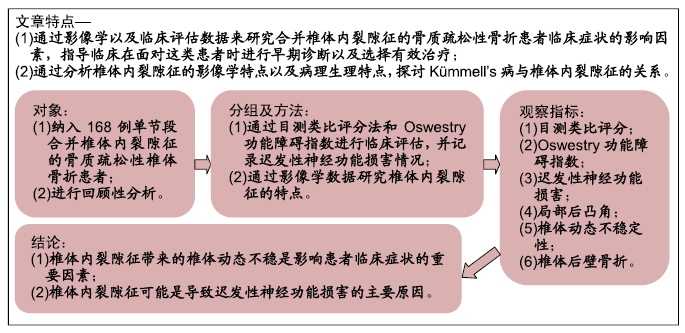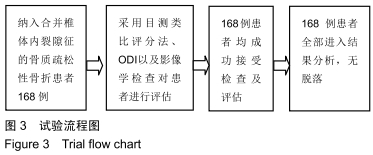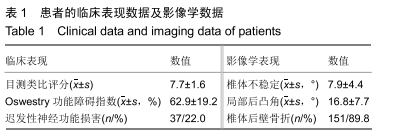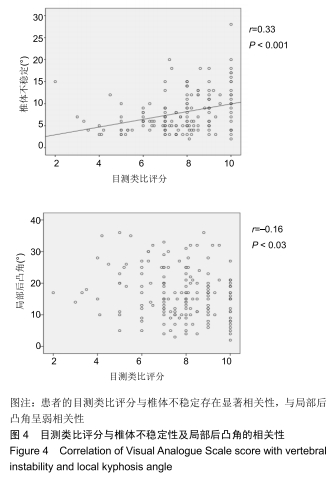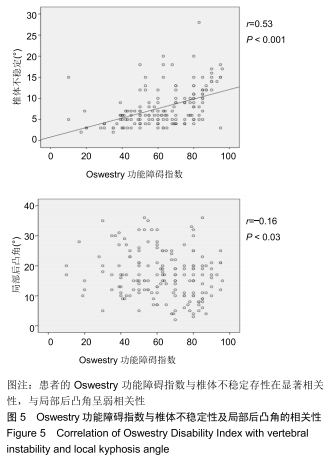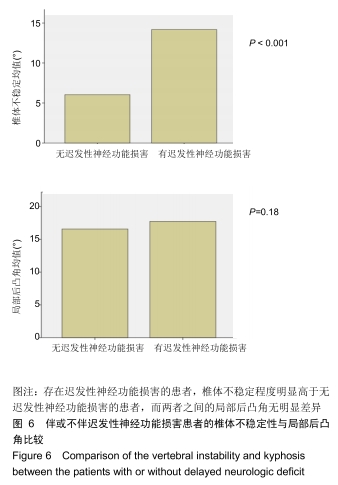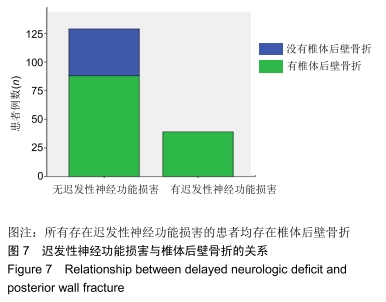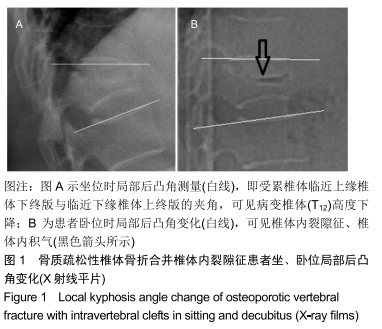[1] 高志祥,李淳,李磊,等.单侧与双侧椎体后凸成形治疗骨质疏松性椎体骨折的Meta分析[J].中国组织工程研究, 2018,22(7): 1140-1148.
[2] 王复案,陈允震.骨质疏松性椎体压缩性骨折诊疗现状及其对策[J].中国骨质疏松杂志,2019,25(5):590-594+599.
[3] TROY KL. Measurement of bone: diagnosis of sci-induced osteoporosis and fracture risk prediction. Top Spinal Cord Inj Rehabil. 2015;21:267-274.
[4] CHOI JH, KANG HD, PARK JH, et al. The efficacy of fentanyl transdermal patch as the first-line medicine for the conservative treatment of osteoporotic compression fracture. Korean J Neurotrauma. 2017;13:130-136.
[5] KIDA K, TANI T, KAWAZOE T. Thoracic radicular pain caused by extravertebral gas and fluid collections associated with osteoporotic vertebral fracture containing a vacuum cleft. Case Rep Orthop. 2019;2019:4284217.
[6] NAKAMAE T, YAMADA K, TSUCHIDA Y, et al. Risk factors for cement loosening after vertebroplasty for osteoporotic vertebral fracture with intravertebral cleft: a retrospective analysis. Asian Spine J. 2018;12:935-942.
[7] ALPANTAKI K, DOHM M, KOROVESSIS P. Surgical options for osteoporotic vertebral compression fractures complicated with spinal deformity and neurologic deficit.Injury. 2018;49: 261-271.
[8] SINGH K, HELLER JG, SAMARTZIS D, et al. Open vertebral cement augmentation combined with lumbar decompression for the operative management of thoracolumbar stenosis secondary to osteoporotic burst fractures. J Spinal Disord Tech. 2005;18:413-419.
[9] KIM H, JUN S, PARK SK, et al. Intravertebral vacuum cleft sign: a cause of vertebral cold defect on bone scan.Skeletal Radiol. 2016;45:707-712.
[10] 常莹,麦筱莉,辛小燕,等. 骨质疏松性椎体压缩骨折骨不连的X线平片和CT及MRI影像学表现[J]. 中华实用诊断与治疗杂志, 2019,33(3):279-282.
[11] LIN CL, LIN RM, HUANG KY, et al. MRI fluid sign is reliable in correlation with osteonecrosis after vertebral fractures: a histopathologic study. Eur Spine J. 2013;22:1617-1623.
[12] PARK HY, AHN JH, HA KY, et al. Clinical and radiologic features of osteoporotic spine fracture with delayed neurologic compromises. World Neurosurg. 2018.
[13] NAKAMAE T, FUJIMOTO Y, YAMADA K, et al. Percutaneous vertebroplasty for osteoporotic vertebral compression fracture with intravertebral cleft associated with delayed neurologic deficit. Eur Spine J. 2013;22:1624-1632.
[14] YEUNG YK. Delayed neurological deficits after osteoporotic vertebral fractures: clinical outcomes after surgery. Asian Spine J. 2017;11:981-988.
[15] NAKAMAE T, FUJIMOTO Y, YAMADA K, et al. Relationship between clinical symptoms of osteoporotic vertebral fracture with intravertebral cleft and radiographic findings. J Orthop Sci. 2017;22(2):201-206.
[16] 俞海明,李毅中,姚学东,等. 经皮椎体成形或经皮椎体后凸成形治疗伴椎体后壁塌陷Kummell病:如何个体化选择[J]. 中国组织工程研究, 2016, 20(26):3856-3862.
[17] KAWAGUCHI S, HORIGOME K, YAJIMA H, et al. Symptomatic relevance of intravertebral cleft in patients with osteoporotic vertebral fracture. J Neurosurg Spine. 2010; 13(2): 267-275.
[18] HOSHINO M, NAKAMURA H, TERAI H, et al. Factors affecting neurological deficits and intractable back pain in patients with insufficient bone union following osteoporotic vertebral fracture. Eur Spine J. 2009;18(9):1279-1286.
[19] KIM DY, LEE SH, JANG JS, et al. Intravertebral vacuum phenomenon in osteoporotic compression fracture: report of 67 cases with quantitative evaluation of intravertebral instability. J Neurosurg Spine. 2004;100(1):24-31.
[20] ATAKA H, TANNO T, YAMAZAKI M. Posterior instrumented fusion without neural decompression for incomplete neurological deficits following vertebral collapse in the osteoporotic thoracolumbar spine. Eur Spine J. 2009;18(1): 69-76.
[21] GLASSMAN SD, ALEGRE GM. Adult spinal deformity in the osteoporotic spine: options and pitfalls. Instr Course Lect. 2003;52:579-588.
[22] FANG X, YU F, FU S, et al. Intravertebral clefts in osteoporotic compression fractures of the spine: incidence, characteristics, and therapeutic efficacy. Int J Clin Exp Med. 2015;8(9):16960.
[23] MOREIRA-GONZALEZ A,DJOHAN R.Considerations surrounding reconstruction after resection of musculoskeletal sarcomas. Cleve Clin J Med. 2010;77 Suppl 1:S18-22.
[24] 李哲,苏庆军,海涌.伴有椎体内裂隙征的骨质疏松性椎体压缩骨折的诊治进展[J].中国脊柱脊髓杂志,2017,27(7):647-651.
[25] WENGER DR. Diagnosis of bone and joint disorders. J Pediatr Orthop. 1988;8(6):725.
[26] FORMICA M, BASSO M, CAVAGNARO L, et al. Kümmell disease: Illustrative case for definition criteria. Spine J. 2016; 16(10): e707-e708.
[27] LIM J, CHOI SW, YOUM JY, et al. Posttraumatic delayed vertebral collapse: Kummell’s disease. J Korean Neurosurg Soc. 2018; 61(1):1-9.
[28] MCKIERNAN F, FACISZEWSKI T. Intravertebral clefts in osteoporotic vertebral compression fractures. Arthrit Rheum. 2014; 48(5):1414-1419.
[29] PARK JW, PARK JH, JEON HJ, et al. Kümmell's disease treated with percutaneous vertebroplasty: minimum 1 year follow-up. Korean J Neurotrauma.2017;13:119-123.
[30] TSUJIO T, NAKAMURA H, TERAI H, et al. Characteristic radiographic or magnetic resonance images of fresh osteoporotic vertebral fractures predicting potential risk for nonunion. Spine. 2011; 36(15):1229-1235.
[31] STÄBLER A, SCHNEIDER P, LINK TM, et al. Intravertebral vacuum phenomenon following fractures: CT study on frequency and etiology. J Comput Assist Tomogr. 1999;23(6): 976-980.
|
